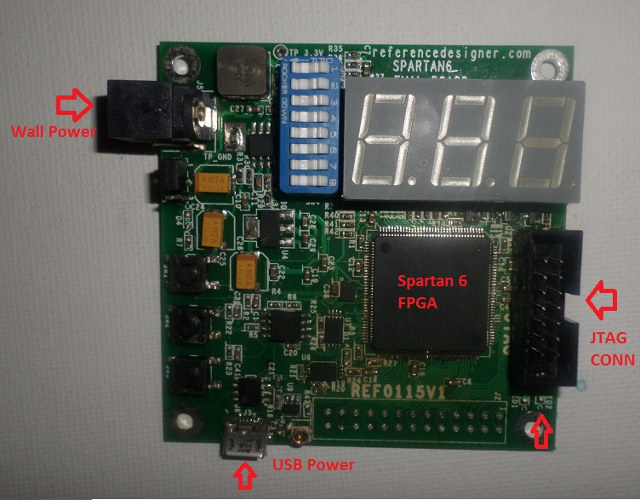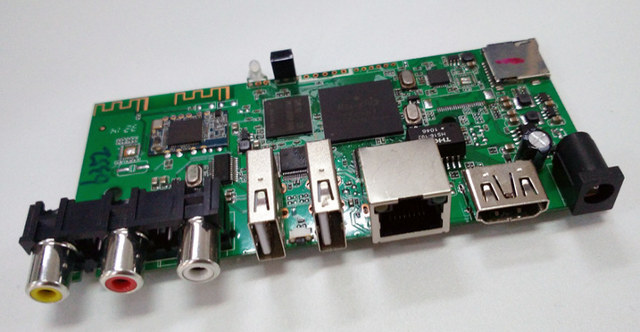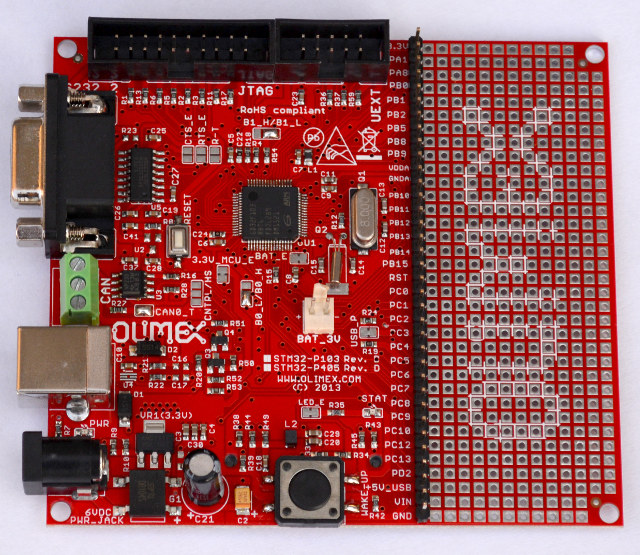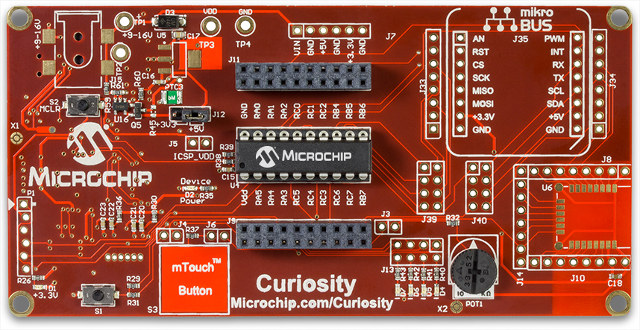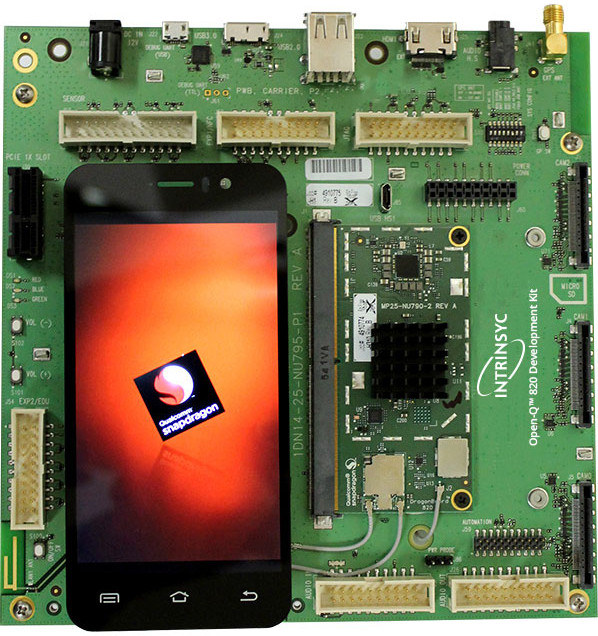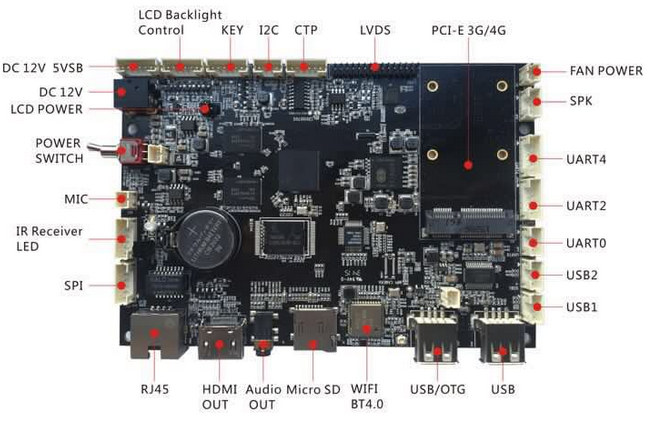Spartixed is another low cost FPGA board launched on Kickstarter, powered by Xilinx Spartan 6 LX4 FPGA, with a 7-segment display, some headers and buttons, and targeting people who want to learn VHDL/Verilog on the cheap. Spartixed board specifications: FPGA – Xilinx Spartan 6 LX4 FPGA (exact part not disclosed) Storage – 16 Mbit flash for program, I2C or SPI EEPROM Display – 3 digit 7- Segment Display USB – 1x micro USB port for power and debugging Expansion – 26-pin unpopulated header, optional SPI Bus A/D Converter Debugging – 14-pin JTAG connector, UARt port via USB connector Misc – 3x push button switches, 8 slide switches for input, 2x user LEDs, 1x power LED, 1x config. ready LED. Power – 5V via Micro USB Connector or 5 to 12 V via external power supply. Dimensions – N/A You can follow the project via its blog, and already access some […]
Rockchip RK3128 TV Box Boards with 512MB RAM, 8GB Storage Sell for $15 and Up
Rockchip RK3036 dual core Cortex A7 processor was showcased by Rockchip at CES 2015 and said to enable $10 H.265 TV boxes, and yesterday I noticed some code made it to mainline Linux for Rockchip RK3036 Kylin board. While I have not been able to find any information about that board, or any other RK3036 boards or devices so far, I’ve been informed that RK3128 boards with 512MB RAM and 8GB storage were selling for $11.50 (75 CNY) for 1K orders, and around $15 (100 CNY) and up for samples. Specifications listed for the board shown above: SoC – Rockchip RK3128 quad core ARM Cortex A7 @ 1.3 GHz with ARM Mali-400MP2 GPU System Memory – 512MB to 1GB LPDDR2/DDR3 or DDR3L Storage – 4 to 8 GB NAND flash + micro SD slot Connectivity – Ethernet, and WiFi Video Output – HDMI 1.4 and composite RCA output Audio Output […]
GigaDevice GD32 is a Faster, Software and Pin-to-pin STM32 Compatible Cortex M3 MCU
Las month, Olimex discovered a Chinese company called GigaDevice has made an STM32 clone called GD32 and compatible with STM32F103, but with higher core frequency (108MHz). Olimex has now posted an update after receiving a letter from GigaDevice, and trying GD32F103RBT6 MCU on their own STM32F103 boards. The company explained that GD32 was their own implementation, and claimed rights on GD32 trademarks, while Olimex discovered than GD32 was working just fine on their board having passed “all functional tests without any modifications”, and with all the same development tools and software code running fine. GD32F103xx datasheet (PDF / English version) can be downloaded to find a few more details: The GD32F103xx device incorporates the ARM Cortex-M3 32-bit processor core operating at 108 MHz frequency with Flash accesses zero wait states to obtain maximum efficiency. It provides up to 3 MB on-chip Flash memory and up to 96 KB SRAM memory. […]
$15 Microchip Curiosity Development Board Supports 8-bit PIC Microcontrollers
I’ve just found out Microchip had introduced Curiosity development board a little while ago, in order to let students and others experiment with their 8-bit PIC DIP MCUs, and including MikroElectronika Mikrobus footprint, an interface for Microchip RN4020 module to add Bluetooth Low Energy, as well as other headers and some extra features like buttons, and a potentiometer. Microchip Curiosity board specifications: MCU – PIC MCU socket for 8, 14, and 20-pin micro-controllers with PIC16F1619 pre-installed. Expansion mikroBUS Click Board footprint Microchip RN4020 Bluetooth Module Footprint USB – USB mini-B connector Misc – Master Clear Reset button, potentiometer, LEDs, mTouch button, push button Power Supply 5V via USB 9V using an external power supply (footprints only) 3.3V to 5V external power supply via TP3 and TP4 pins Dimensions – N/A There are over 160 MikroElektronika Click boars on the market now, but only seven are listed with code samples for […]
DietPi is Lightweight, Easy to Use Debian Based Distribution for Raspberry Pi, ODROID, and Orange Pi Boards
Raspberry Pi, Hardkernel ODROID, and Orange Pi are some of the most popular and cost effective development boards on the market today, and one British developer, going under Fourdee nickname, has released a lightweight distribution called DietPi working for all Rasbperry Pi boards, ODROID-C1(+), ODROID-XU3/XU4, and Orange Pi PC, with Orange Pi 2 and Orange Pi Plus support coming soon, as well as a VMWare virtual machine also available for evaluation. The compressed downloads are about 80 to 100MB depending on the target, the image that can be dump with dd or Win32DiskImager requires a 1GB or greater micro SD card as the image itself is about 500MB large, Internet access (Ethernet or Wifi), and optionally a USB Drive to allow installation on a USB drive for better performance, which of course does not apply if you have an eMMC module with your ODROID board. The image also contains some […]
Intrinsyc Introduces Qualcomm Snapdragon 820 Cortex-A72-Class Development Board, SoM and MDPs
While there’s already an healthy choice of ARMv8 development board such as LeMaker Hikey, or Qualcomm DragonBoard 410c, all those platforms are based on the lower end Cortex A53 64-bit ARM core, and ARM Cortex A57, let alone Cortex A72, boards are much more difficult to find, as they are much pricier and/or have limited availability. Intrinsyc may have released the first (somewhat) affordable and accessible Cortex-A72-class development board with Open-Q 820 development kit comprised of a SoM and a baseboard, as well as smartphone and tablet mobile development platforms (MDPs) based on Qualcomm Snapdragon 820 quad core Kryo processor. While Kryo is a custom ARMv8 designed by Qualcomm, and not exactly a Cortex A72 core, both have similar performance, as shown in Snapdragon 820 Antutu and Kirin 950 Antutu results. Open-Q 820 board specifications: SoC – Qualcomm Snapdragon 820 quad core Kryo cores with 2x cores @ up to […]
ADBoard 3G/4G Digital Signage Board is Powered by Allwinner A83T Octa-Core Processor
MQMaker officially launched their WiTi router board earlier this week, but the company has also introduced ADBoard, an octa-core board specifically designed for digital signage with a connector for LVDS display including backlight, an RTC with backup battery, and a mini PCIe connector for 3G/4G connectivity combined with a SIM card slot. ADBoard specifications: SoC – Allwinner A83T octa-core ARM Cortex-A7 @ 2.0 GHz with PowerVR SGX544MP GPU @ 700 MHz supporting OpenGL ES 2.0/1.1, OpenCL 1.1, and DX 9.3. System Memory – 1 GB DDR3 Storage – 16 GB eMMC + micro SD slot Display Interfaces / Video Output HDMI up to 1080p60 with HDCP 1.2 and CEC support connector LVDS connector, LCD backlight control header and capacitive touch panel header Audio – HDMI, 3.5mm audio output, speaker connector, microphone connector Connectivity – Gigabit Ethernet, 802.11 b/g/n Wi-Fi and Bluetooth 4.0 USB – 1x USB 2.0 host port, 1x […]
$15 pcDuino3 Nano Lite Board Includes Gigabit Ethernet and a Real SATA Port
I often read people complain about the lack of SATA and Gigabit Ethernet on devices, and following up a discussion on a recent post about QNAP TAS-168 and TAS-268 NAS, I was made aware that pcDuino3 Nano board had a little brother without NAND Flash, nor an IR receiver that’s currently selling for $15 on Amazon US. pcDuino3 Nano Lite board specifications are exactly the same as the other version minus the stricken-through items: SoC – AllWinner A20 dual core ARM Cortex A7 @ 1.0 GHz with Mali 400MP2 GPU System Memory – 1GB DRAM Storage – 4GB NAND Flash, SATA connector and microSD card slot (up to 32GB) Video Output – HDMI 1.4 with HDCP support Audio Out – 3.5mm analog audio interface Connectivity – Gigabit Ethernet USB – 2x USB host, 1x USB OTG Expansion Headers – Arduino UNO extension interface with 14xGPIO, 2xPWM, 6xADC, 1xUART, 1xSPI, 1xI2C. […]


